Coregonine Captive Broodstock Developed from Wild-Caught Juveniles: Dual Strategies to Mitigate Barotrauma-Induced Mortality
Contributing Authors
Dale Hanson (FWS, dale_hanson@fws.gov); Nicole Watson (USGS); Owen Gorman (USGS); Dan Yule (USGS); Kevin Keeler (USGS); Mike Seider (FWS); Craig Bockholt (FWS); Brandon Keesler (FWS); Orey Eckes (FWS); Jamie Dobosenski (TNC); Charles Bronte (FWS); Roger Gordon (FWS); Amanda Ackiss (USGS); Jason Smith (Bay Mills Indian Community); Gary Michaud (Little Traverse Bay Bands of Odawa Indians); Matthew Herbert (TNC); Ben Breaker (FWS); Dimitry Gorsky (FWS)
Project Description
To date, reintroductions of extirpated native coregonines have relied on hatchery broodstock created via gametes from wild populations. However, gamete-based methods, e.g., human-induced spawn-pairings of wild captured adults in the field, may alter allelic frequencies relative to the donor population and risk hybridization among coregonine forms. Therefore, we view wild-captured juvenile coregonines as a potentially superior method of sourcing hatchery broodstock. In FY2022, this team’s pilot project was funded to explore live-capture methods for broodstock collections from wild juvenile coregonines using specialized trawls, an Aluette trawl to target capture depths of 2 – 15m, and a floating Mamou trawl targeting 0 – 2m depths. Each of these nets were equipped with an aquarium style cod-end designed to minimize injury during the capture process.
Key lessons emerged from this pilot study. Trawls with aquarium cod-ends enabled capture of juvenile coregonines with little immediate mortality. Road transport to the hatchery was a stressor, but the root cause of mortality stems from barotraumatic injuries. Notably, we did not anticipate barotrauma symptoms as these juveniles were captured in the upper 10 m of the epilimnion; but we now suspect that age-1+ juveniles made deeper diel vertical migrations prior to capture, and thus were predisposed to barotrauma when held at surface atmospheric pressures. Therefore, our current proposal employs two distinct strategies to build upon this work by 1) mitigating barotrauma of age 1+ coregonines via recompression in a vessel-based hyperbaric chamber, and 2) focusing on capture of age-0 life-stages in the epilimnion prior to development of diel vertical migration behaviors.
